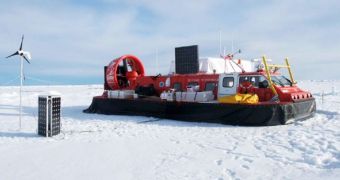In spite of the fact that hovercraft are usually used for navigating swamps and shallow waters, a few modifications are, apparently, enough to turn them into potent scientific tools. Researchers Yngve Kristofferson and John Hall are planning to use a modified Griffon Hovercraft 2000TD to analyze a patch of Arctic sea floor, which they believe may house the impact crater left behind by a massive asteroid hitting the Earth in the past.
The craft has been endowed with a number of scientific instruments, as well as with solar panels, and has also been extensively modified so that it can withstand weeks of non-stop polar explorations. The two researchers need to cover an area of about 22,000 square miles, so they have to be as efficient about it as possible, Wired reports. John Hall, who is a retired geoscientist, first noticed the anomaly at the bottom of the ocean in the late 1960s, as part of his graduate work.
In the following decades, no ships returned to the Fletcher’s Ice Island area to conduct more measurements of the peculiarities, he says, therefore he has taken it upon himself to do so personally. Because he is the partial heir of the American Chicle Company head's fortune, he could afford to purchase the hovercraft with private funding. The ACC was the leader of the chewing-gum market in its earliest days. On October 6, the expert delivered a speech praising the hovercraft's abilities at the Columbia University Lamont Doherty Earth Observatory.
“The neat thing with a hovercraft is that you drive with the same ease over 10 centimeter-thick ice as you do with five meter thick ice,” Kristofferson said. The construction of hovercraft in general relies on pumping air under a rubber “skirt,” which makes them able to barely touch the surfaces they are driving over. For instance, the six-ton Griffon weighs as much on the ice as a seagull standing on one leg. This makes it especially suitable for navigating thin ice, where other ships would have problems.
“The craft has proved to be useful for a variety of scientific tasks. It appears more efficient than any other platform for ice-thickness measurements and oceanographic work,” the two experts wrote in a new paper, published in the August issue of the journal The Leading Edge.

 14 DAY TRIAL //
14 DAY TRIAL //